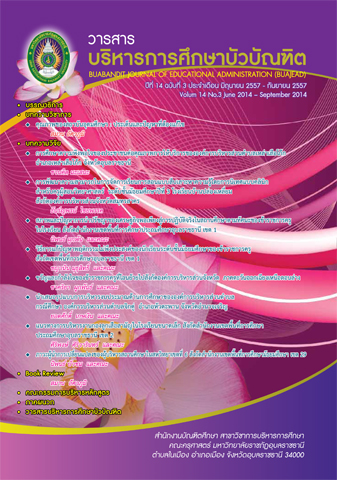วิธีการแก้ปัญหาพฤติกรรมไม่พึงประสงค์ของนักเรียนระดับชั้นมัธยมศึกษา ของข้าราชการครู สังกัดสำนักงานเขตพื้นที่การศึกษาอุบลราชธานี เขต 1
Main Article Content
บทคัดย่อ
การวิจัยครั้งนี้มีวัตถุประสงค์เพื่อศึกษาและเปรียบเทียบวิธีการแก้ปัญหาพฤติกรรม ไม่พึงประสงค์ของนักเรียนชั้นมัธยมศึกษาของข้าราชการครู สังกัดเขตพื้นที่การศึกษา อุบลราชธานี เขต 1 จำแนกตาม เพศ วุฒิการศึกษา ประสบการณ์ทำงาน และขนาดโรงเรียน
กลุ่มตัวอย่างที่ใช้ในการวิจัยได้แก่ข้าราชการ ครู จำนวน 189 คน กำหนดขนาดของกลุ่มตัวอย่าง โดยใช้เกณฑ์ของ Krejcie and Morgan ซึ่งได้มาโดยการสุ่มแบบแบ่งชั้น (Stratified Random Sampling) เครื่องมือที่ใช้ในการ รวบรวม ข้อมูล คือ แบบสอบถามแบบมาตราส่วนประมาณ ค่า 5 ระดับ ซึ่งแบ่งออกเป็นเป็น 6 วิธี คือ วิธีการ ค้นหาสาเหตุของพฤติกรรมที่ไม่พึงประสงค์และหาทางแก้ไขวิธีการให้คำปรึกษาวิธีการแนะนำวิธีการลงโทษวิธีการทำสัญญาเงื่อนไข และวิธีการเสริม แรงพฤติกรรมที่พึงประสงค์ซึ่งมีค่าความเชื่อมั่น ทั้งฉบับ เท่ากับ .97 สถิติที่ใช้ในการวิเคราะห์ข้อมูล ได้แก่ ค่าร้อยละ ค่าเฉลี่ย ส่วนเบี่ยงเบนมาตรฐาน การทดสอบค่า t และการทดสอบค่า F
ผลการวิจัยพบว่า
1. วิธีการแก้ปัญหาพฤติกรรมไม่พึงประสงค์ของนักเรียนระดับชั้นมัธยมศึกษาตาม ความคิดเห็นของข้าราชการครูสังกัดเขตพื้นที่การศึกษาอุบลราชธานี เขต 1 เมื่อพิจารณาโดยภาพรวมและรายวิธีอยู่ในระดับมาก
2. ผลการเปรียบเทียบวิธีการแก้ปัญหาพฤติกรรมไม่พึงประสงค์ของนักเรียนระดับชั้นมัธยมศึกษาของข้าราชการครูสังกัดเขตพื้นที่ การศึกษาอุบลราชธานี เขต 1 แยกเป็นรายด้าน ดังนี้
2.1 วิธีการแก้ปัญหาพฤติกรรมไม่พึงประสงค์ของนักเรียนระดับชั้นมัธยมศึกษาของข้าราชการครูสังกัดเขตพื้นที่การศึกษา อุบลราชธานี เขต 1 จำแนกตามเพศ ในภาพรวม พบว่า ข้าราชการครูที่เป็นชายและหญิง มีวิธีการแก้ปัญหาพฤติกรรมของนักเรียนไม่แตกต่างกัน เมื่อพิจารณาในรายวิธี พบว่า วิธีการแนะนำเป็นวิธีที่ครูชายและครูหญิง นำไปใช้แก้ปัญหา พฤติกรรมที่ไม่พึงประสงค์ของนักเรียน แตกต่างกัน อย่างมีนัยสำคัญ ทางสถิติที่ระดับ .05 ส่วนวิธีอื่นๆ พบว่า ไม่แตกต่างกัน
2.2 วิธีการแก้ปัญหาพฤติกรรม ไม่พึงประสงค์ของนักเรียนระดับชั้นมัธยมศึกษา ของข้าราชการครูสังกัดเขตพื้นที่การศึกษา อุบลราชธานี เขต 1 จำแนกตาม วุฒิการศึกษา ในภาพรวม พบว่า ข้าราชการครูที่จบการศึกษา ปริญญาตรี และสูงกว่าปริญญาตรี มีวิธีการ แก้ปัญหาพฤติกรรมไม่พึงประสงค์ของนักเรียน แตกต่างกันอย่างมีนัยสำคัญทางสถิติที่ระดับ .05 เมื่อพิจารณาในรายวิธี พบว่า วิธีการลงโทษ วิธีการ ทำสัญญาเงื่อนไข และวิธีการเสริมแรงพฤติกรรม ที่พึงประสงค์ เป็นวิธีที่ครูจบปริญญาตรี และสูง กว่าปริญญาตรี ใช้แก้ไขปัญหาพฤติกรรมที่ไม่พึง ประสงค์ของนักเรียนแตกต่างกันอย่างมีนัยสำคัญ ทางสถิติที่ระดับ .05 ส่วนวิธีอื่นๆ พบว่า ไม่แตก ต่างกัน
2.3 วิธีการแก้ปัญหาพฤติกรรม ไม่พึงประสงค์ของนักเรียนระดับชั้นมัธยมศึกษา ของข้าราชการครู สังกัดเขตพื้นที่การศึกษา อุบลราชธานี เขต 1 จำแนกตามประสบการณ์ ทำงานในภาพรวม พบว่าครูที่มีประสบการณ์ ทำงานตํ่ำกว่า 10 ปี และครูที่มีประสบการณ์ทำงาน 10 ปขี ึน้ ไป มวี ธิ กี ารแกป้ ญั หาพฤตกิ รรมไมพ่ งึ ประสงค์ ของนักเรียนไม่แตกต่างกัน เมื่อพิจารณาในรายวิธี พบว่า วิธีการแนะนำ เป็นวิธีที่ครูที่มีประสบการณ์ ทำงาน ตํ่ำกว่า 10 ปี และครูที่มีประสบการณ์ทำงาน 10 ปีขึ้นไป ใช้แก้ไขปัญหาพฤติกรรมที่ไม่พึง ประสงค์ของนักเรียน แตกต่างกันอย่างมีนัยสำคัญ ทางสถิติที่ระดับ.05 ส่วนวิธีอื่นๆ พบว่า ไม่แตกต่างกัน
2.4 วิธีการแก้ปัญหาพฤติกรรมไม่พึงประสงค์ของนักเรียนระดับชั้นมัธยมศึกษาของข้าราชการครู สังกัดเขตพื้นที่การศึกษา อุบลราชธานี เขต 1 โดยรวมและรายวิธี จำแนกตามขนาดโรงเรียน พบว่ามีการปฏิบัติไม่แตกต่างกัน
3. ข้อเสนอแนะ
3.1 ควรมีการจัดเก็บทะเบียน นักเรียนเป็นรายบุคคลที่เป็นระบบมากกว่านี้ และ สามารถสืบค้นข้อมูลได้ตลอดเวลา ควรมีการเรียนเชิญผู้ปกครองมาร่วมประชุมเพื่อหาแนวทาง แก้ไขปัญหาพฤติกรรมเมื่อพบว่านักเรียนมีพฤติกรรมที่เปลี่ยนไป
3.2 ครูทุกคนควรให้คำปรึกษาและช่วยเหลือนักเรียนในด้านการเรียน และปัญหาต่างๆ ของนักเรียนเสมอและทั่วถึงทุกคน
3.3 ครูควรให้คำแนะนำนักเรียนสำหรับนักเรียนที่มีความประพฤติที่ผิดเพื่อให้นักเรียนปรับปรุงแก้ไข ควรมีการจัดประชุมผู้ปกครองนักเรียนเพื่อปรับความเข้าใจ และหาแนวทางแก้ไขพฤติกรรมของนักเรียนร่วมกัน เมื่อพบว่าพฤติกรรมของนักเรียนเปลี่ยนไป
3.4 ครูที่ปรึกษาควรตั้งกฎประจำห้องเรียนที่ทุกคนต้องปฏิบัติร่วมกันและตั้งโทษของผู้กระทำผิดไว้ด้วยการทำโทษนักเรียนของครู ไม่ควรทำการเฆี่ยนตี ควรให้นักเรียนทำกิจกรรมบำเพ็ญประโยชน์แทน
3.5 ครูให้โอกาสนักเรียนแก้ไขเมื่อนักเรียนทำความผิด ครูเรียกมาตักเตือนและให้นักเรียนรีบไปแก้ไขแล้วมารายงานตัวทันที
3.6 ควรมีการสำรวจความต้องการ องนักเรียนในด้านต่างๆ และเก็บรวมรวมข้อมูลไว้เป็นหลักฐาน ควรเรียนเชิญผู้ปกครองนักเรียนเข้าร่วมประชุมให้โอกาสได้แสดงความคิดเห็นนำเสนอข้อมูลเกี่ยวกับนักเรียน มีการบันทึก หลักฐานการประชุมเกี่ยวกับการดูแล ช่วยเหลือนักเรียน และมีการประเมินผลการประชุมพร้อมรายงานผล
An Undesirable Behavioral Solution of Matthayom Suksa Students of Government Teachers under the Ubon Ratchathani Secondary Educational Service Area 1
The objective of this study was to investigate and compare the means to solve the undesirable behaviors of Mathayom Suksa students of the teachers under the Ubon Ratchathani Secondary Educational Service Area 1 as classified by their gender, educational level, work experience, and school size.
The samples included 189 school teachers selected by means of the stratified random sample method. The table of Krejcie and Morgan was employed in determining the sample group size. A 5-point rating scale survey questionnaire yielding the overall reliability of.97 was used in data collection. The means in the problem solution on the questionnaire covered 6 methods namely the problem cause findings and solution strategies, counseling method, punishment method, conditional contract method, and positive behavioral reinforcement method. The statistics including percentage, mean, standard deviation, t-test, and F-test were used in data analysis.
The research findings were as follows:
1. The solution of undesirable behaviors of Matthayom Suksa students of the teachers under the Ubon Ratchathani Secondary Educational Service Area 1 was found to be overall and individual aspects at a high level.
2. The comparison of the solution of undesirable behaviors of Matthayom Suksa students was found as follows:
2.1 The overall solution of undesirable behaviors employed by both female and male teachers was not different. However, the difference at level .05 of significance was found in the employment of individual aspect method namely the counseling method.
2.2 The teachers obtaining bachelor and higher than bachelor degrees were found to be different at level .05 of significance in the overall solution of undesirable behaviors; the teachers were found to different in the use of the punishment method, conditional contract method, and positive behavioral reinforcement method for solution of undesirable behaviors of Matthayom Suksa students.
2.3 The teachers having been in less than 10 year and more than 10 years of service length were not found to be different at a significant level in the overall solution of undesirable behaviors. However, the teachers were found to different at level .05 of significance in the use of the counseling method.
2.4 The teachers working in schools with different size were not found to be different at a significant level in the overall and in the individual aspects of the solution of undesirable behaviors.
3. Suggestions:
3.1 Individual student records should be systematically organized for the convenient accessibility. Parents should be invited to get involved in the solution when the change in behavior of the students was found.
3.2 Every teacher should regularly give counseling on learning and problems to every student.
3.3 Teachers should give advice to students when they misbehaved and allowed them to improve their behaviors; parents should be invited to the meetings to find the ways for solutions.
3.4 Counseling teachers should set up classroom regulations that allowed the students to follow; punishment should not be flogging but giving public services instead.
3.5 Teachers should let the students who misbehaved know their wrongdoings and give them the opportunity to improve and follow up their improvements.
3.6 Needs assessments in various aspects should be done and the results should be kept for references and evidence for the needs fulfillment; parents should be also invited to voice their opinions and advice on students. Meeting on student support in all respect should be recorded and reported.

